Cabbage Information
Click for information on...
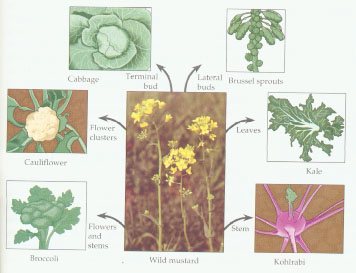 All true cabbages belong to the Brassica genus, a group within the Cruciferae or Brassicaceae (mustard) family, comprising about 30 species of annual, biennial and occasionally perennial herbs with yellow or white flowers.
A large number of the familiar cabbages seen today are sub-species of Brassica oleacea, a very variable annual or perennial herb with a large number of cultivars. This includes the plain old and purple cabbage, brussels sprouts, cauliflower and broccoli.
All true cabbages belong to the Brassica genus, a group within the Cruciferae or Brassicaceae (mustard) family, comprising about 30 species of annual, biennial and occasionally perennial herbs with yellow or white flowers.
A large number of the familiar cabbages seen today are sub-species of Brassica oleacea, a very variable annual or perennial herb with a large number of cultivars. This includes the plain old and purple cabbage, brussels sprouts, cauliflower and broccoli.
However, there are many more Brassica members than just these well known few. On the following pages is information about cabbage cousins and other members of the Brassica family, many of which incorporate "cabbage" into their common name, and share characteristics with the vegetables we know and love.
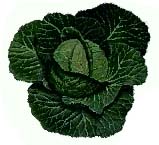
The Plain Old Cabbage
Brassica oleacea var. capitata
The plain old cabbage, also known as the drumhead, is a biennial herbaceous plant that produces large, waxy leaves surrounding smaller tightly packed head leaves in the first year, and a flower stalk bearing yellow flowers the second year. Its varietal name, "capitata" means "in the form of a head". In cultivation, it takes 90 to 120 days from seed to harvest, often being transplanted as a seedling from a nursery to a field at a young age. Its natural distribution is throughout the Mediterranean and South West Europe, and it has been cultivated since antiquity in these areas.
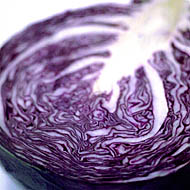
The Purple Cabbage
Brassica oleacea var. capitata
Purple (or red) cabbages resemble the plain old cabbage, being hard, tightly packed and crisp biennial herbs. Purple cabbages however possess beautiful dark red or crimson leaves instead of the green or white ones of most other cabbage varieties. They grow all year round but are most plentiful in autumn and winter.
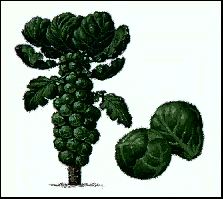
The Brussels Sprout
Brassica oleacea var. gemmifera
Unlike most of its relatives, the brussels sprout plant can grow up to one hundred separate heads on each plant. Each sprout is a tightly packed cabbage in miniature. The varietal name "gemmifera" means that the plant reproduces by gemmae of leaf buds, which when detached from the mother plant are capable of rooting and forming a new mature plant. In early life the plant resembles its cabbage forbears, but later stem buds develop into miniature heads.
It thrives in cool temperatures and is thought to have first been grown in quantity near Brussels, Belgium, during the 16th century, giving it its name.
For information on the biochemsitry of brussels sprouts, follow this link to Swedish Christmas Cabbage Chemistry.
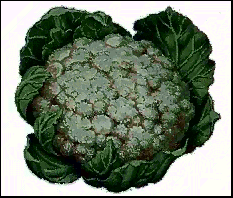
The Cauliflower
Brassica oleracea var. botrytis
The cauliflower produces a single stem bearing a curd, a large round flowerhead of tightly packed underdeveloped flower buds, which nestles in the surrounding leaves. The word cauliflower comes from the Latin "stem of a plant" and "flower", referring to the edible head of compressed flower buds on a thickened stem that makes up the cauliflower.
The cauliflower is native to the Mediterranean and thrives in cool and moist conditions. It comes in three basic colours: white (the most popular and readily available), green and purple (a vibrant violet that turns pale green when cooked).
Cauliflower readily hybridises with related cabbage varieties to form interesting novelties, such as the Broccoflower, a hybrid of cauliflower and broccoli, which has light green florets (as in brocoli) packed into a round head (as in cauliflower).
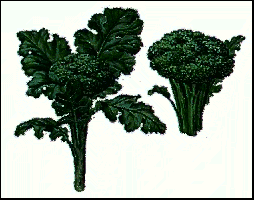
Broccoli
Brassica oleracea var. botrytis
The broccoli plant produces a head formed from loose terminal clusters of flower heads (florets) on several branches and many smaller heads in the axils of leaves lower down branches. The varietal name "botrytis" means a bunch of grapes, and refers compact buds that make up the head. The word "broccoli" comes direct from Italian, meaning sprout or cabbage sprout.
It is well suited to mild coastal climates and usually grown from seed. There are numerous broccoli hybrids and varieties, for example purple broccoli, Italian or Asparagus broccoli, Romanesco broccoli, Chinese sprouting broccoli or Calabrese and brocoflower (see above).
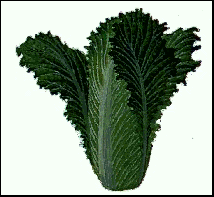
Chinese Cabbages
The name "Chinese cabbage" is a confusing one and tends to include all cabbages originally grown in China and recently introduced to the west.
Unlike the four previously mentioned cabbage varieties, Chinese cabbages belong to the species Brassica rapa, a group which also includes turnips and spinach mustard.
Chinese cabbage varieties are notably stronger in flavour and faster growing than other members of the cabbage family. Chinese cabbages resemble the drumhead in that the leaves comprise the bulk of the plant, but the head of the Chinese cabbage is more loosely packed, with fewer leaves being produced. There are two main Brassica subspecies that are classified as Chinese cabbages, Brassica rapa var. pekinensis and Brassica rapa var. chinensis.
- Brassica rapa var. pekinensis is also called the Chinese cabbage, celery cabbage, napa cabbage, hakusai, wong bok and Peking cabbage. The predominant variety has crinkly, thickly veined leaves that are cream-colored with celadon green tips. Unlike the strong-flavoured waxy leaves on round heads of plain old cabbage, these are thin, crisp and delicately mild.
- Brassica rapa var. chinensis is known as Chinese white cabbage, bok choy, pak choi (pak choy), bok celery, celery mustard and white mustard cabbage. It is a mild, versatile vegetable with crunchy white stalks and tender, dark green leaves. It resembles a bunch of wide-stalked celery with long, full leaves.
Cabbage Information 2 - Unusual Cabbages


 All true cabbages belong to the Brassica genus, a group within the Cruciferae or Brassicaceae (mustard) family, comprising about 30 species of annual, biennial and occasionally perennial herbs with yellow or white flowers.
A large number of the familiar cabbages seen today are sub-species of Brassica oleacea, a very variable annual or perennial herb with a large number of cultivars. This includes the plain old and purple cabbage, brussels sprouts, cauliflower and broccoli.
All true cabbages belong to the Brassica genus, a group within the Cruciferae or Brassicaceae (mustard) family, comprising about 30 species of annual, biennial and occasionally perennial herbs with yellow or white flowers.
A large number of the familiar cabbages seen today are sub-species of Brassica oleacea, a very variable annual or perennial herb with a large number of cultivars. This includes the plain old and purple cabbage, brussels sprouts, cauliflower and broccoli. 





